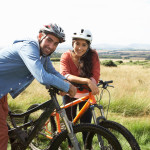 Bikes are a healthy and environmentally friendly way to get around cities and towns. Biking is a fun way to get your daily exercise, as long as you follow the rules of the road.
Bikes are a healthy and environmentally friendly way to get around cities and towns. Biking is a fun way to get your daily exercise, as long as you follow the rules of the road.
Where can I ride?
Many roads have a designated bike lane, and you should travel along the designated path. In many areas, riding on the sidewalk is illegal. Take this survey to see if it’s safe to ride a bike in your community.
Should I ride with traffic or against traffic?
You should always ride with traffic. Stay on the right side of the road, so that both you and the cars are traveling in the same direction.
What are the basic bike traffic rules?
- Follow traffic rules that apply to cars. For example, if the traffic light turns red, you must stop at the light.
- Use hand signals to communicate with drivers.
- Be aware of the traffic around you. Look for cars turning, stopping, etc., especially at intersections and when leaving your driveway.
- Don’t ride too closely to cars, including parked cars. You never know when a door is going to open!
- If you’re riding with friends, ride single file. When riding with friends, everyone needs their own bike. Pegs and friends sitting on your handlebars is illegal.
- Look out for potholes, bumps, drain grates, and other hazards.
What are the correct hand signals?
- Stopping: Hold your left hand down and bend your elbow to make an upside down “L” shape.
- Left Turn: Hold your left arm straight out.
- Right Turn: Hold your left hand up and bend your elbow to make an “L” shape. You can also hold out your right arm.
What are some general safety tips?
Pay attention to your surroundings when riding, for your own safety and for the safety of others.
Here are some things to avoid while riding:
- Headphones:You might not hear cars if you are listening to loud music.
- Cell phones: Talking or texting can be a major distraction.
- Bicycle tricks: Save these for when you’re on a road with no cars around.
How can I tell if my bike is the right fit for my body?
It’s important that the adjustments on your bike allow you to be comfortable.
Here are some ways to tell if your bike fits your body well:
- Your feet will be flat on the ground when you stand over the bike frame. There should be a couple of inches between the top metal bar and your crotch. (A mountain bike will have more space.)
- The seat should be set high enough so that your legs can be almost straight (your knees will be bent a little) when you have your feet on the pedals.
- On a road bike, the handlebars should be 1 to 2 inches lower than your seat (3 to 4 inches for a mountain bike).
Why should I wear a helmet?
- Bike accidents can and do happen, even when you are very careful. In fact, each year thousands of children, teens, and adults require emergency care because of an accident involving a bicycle. Head injuries are very serious and can change your life in an instant. Many people die from head injuries caused from bike accidents each year. Wearing a helmet helps protect your head and your brain, but it doesn’t mean you should take risks or try fancy tricks. Leave that to the professionals!
- Ideally, it would be great if you could wear an outfit that protects your entire body when you go for a bike ride, but you can reduce the risk of brain injury by wearing a helmet that fits well. Bike helmets are not just practical; they can be stylish and come in lots of colors. You can even decorate them with reflective stickers that make you more visible to others on the road.
- According to the American Academy of Pediatrics, bicycle helmets are up to 88% effective in reducing head and brain injuries, making the use of helmets the single more effective way to prevent head injuries and death resulting from bicycle crashes.
How do I know if my helmet fits?
A helmet fits correctly if:
- It is level on your head and covers your forehead.
- It does not rock back and forth.
- The straps form a “V” around your ears. Adjust the straps if they don’t. You should be able to fit only one or two fingers under the chin strap.
- Your helmet should feel tighter when you open your mouth wide. If not, tighten the strap.
- Make sure that any helmet you buy has a sticker certifying that it has been tested and meets safety standards. The helmet should be certified by the Consumer Product Safety Commission (CPSC).
Before you wear a helmet, you should read any instructions that come with it.
What clothes should I wear when riding?
- Wear bright colors. This makes it easy for others to see you on the road, even in the daytime. Avoid wearing black or other dark colors.
- Wear clothes with reflective materials when you’re riding at night. If you don’t have reflective clothing, you can put reflective stickers on your body and/or your backpack.
- Wear pants that fit close to your body. Loose pant legs can catch on the chain.
- Avoid wearing shoes that slip on the pedals. Sturdy, closed-toed shoes should be worn to protect your toes. Make sure your laces are tied.
- Tie any loose straps when wearing a backpack.
How do I take good care of my bike?
Always check for the following:
- The air pressure in the tires is correct
- The brakes work
- The chain is not rusty, but greasy and tight
- The seat is not wobbly or loose
- The wheels are locked in
- There are no loose spokes
- Reflectors on the front and the back of your bike
Now you’re ready to take off on your bike:
- You’ve got an approved safety helmet that fits well
- You’ve got a bike that’s the right fit for your body
- You’re wearing reflective or white, bright clothing
- You know the rules of the road, the proper hand signals to use, and where it is safe to ride
- You’ve checked to make sure that your bike is in good working order
Get out on your bike and have fun!
Source: Read Full Article





